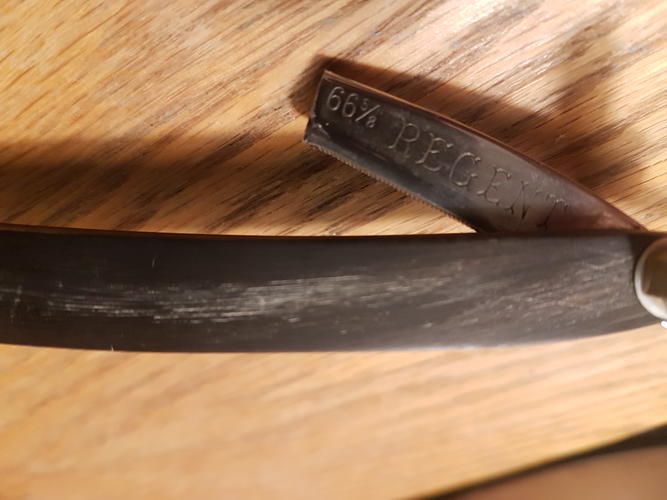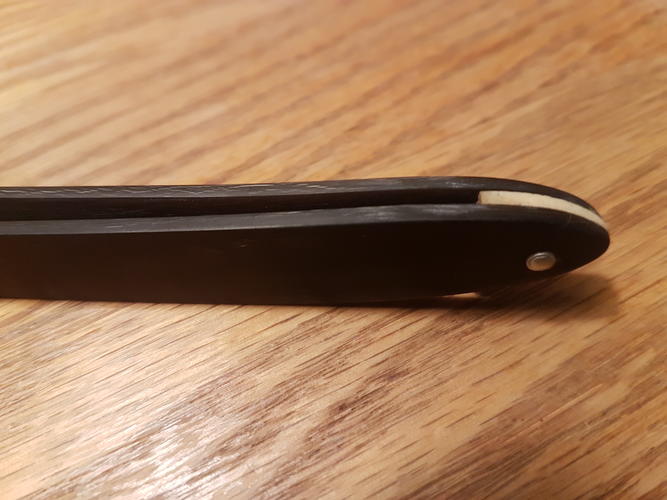Results 1 to 10 of 23
Thread: Lines in Black Horn
-
02-05-2020, 02:01 AM #1Senior Member

- Join Date
- Dec 2016
- Posts
- 283
Thanked: 61 Lines in Black Horn
Lines in Black Horn
Hi folks,
So, I salvaged a set of very old black horn scales from a junker and went about touching them up to use on some unknown future project. This is my first experience with horn but I felt pretty confident reading through the various discussions of it on here. I didn't think about before pictures, but obviously wish I had now. When I got them, one had almost a twist in it with the edges curled up, both bowed heavily in one direction, and they both had bites out of them.
I began by boiling and pressing them to get them as flat as possible and then soaked them in neatsfoot oil for well over a week. Then I took it handsanding. I made them more narrow to sand out the bites and then thinned them out on both outside and inside to remove any curl that was left; the scales were quite thick to begin with so I had lots of material to work with as I sanded down.
I've now handsanded them to 3000 and re-pinned the one end with the original bone wedge (ignore the old broken tang I use for mock-ups). The problem I'm having is that there are little white lines throughout the scales, both on the edges and at several points on the sides. These were apparent when I first began but I assumed they were just scratches that would sand out -- they are definitely not scratches. Is this normal? Anything to be concerned with? Or, just leave them as they are as part of the deal with using natural (and very old!) materials. Any thoughts or suggestions would be greatly appreciated.
Cheers, folks!


-
02-05-2020, 02:29 AM #2

Are you wet sanding? Try using water while you sand. I shape with scrapers mostly but when I start sanding I go with 220 and water. I have a piece of plate glass I throw over the center divider in our sink and set the faucet to a drip, almost a trickle. It doesn’t take much you just need to keep everything wet while you sand. Check constantly, you can really remove a lot of material in a short period of time when wet sanding. To check progress wipe the scale with an absorbent cloth and look at it while holding under some light. It should be evident if you need to sand anymore with a given grit.
-
02-05-2020, 02:34 AM #3Senior Member

- Join Date
- Dec 2016
- Posts
- 283
Thanked: 61
I have done both dry sanding and wet sanding and it doesn't appear to make a difference. I've probably remove 0.5mm (1/50 of an inch) off that side and it hasn't altered those markings in the least. They feel as smooth as the rest of the horn and feel almost glassy right now.
-
02-05-2020, 02:42 AM #4

How does the area look under a loupe? Can you see the spot if you look at it from a low angle? May help you to see if the defect is at the surface or just what that particular piece of horn just looks like. Outback will probably be by soon, he has dealt with a ton of horn and has probably come across your particular situation. Every time I have had something that looks like your issue it’s been because of something I did.
-
02-05-2020, 03:14 AM #5

So the long deceased bovine who donated it's horns to make scales with had came with streaks in it. So what

If you want all black, then put those scales in some black hair dye or some black leather dye.
You might need to give them a quick soak in something to remove the Neatsfoot oil, but I'd try just giving them a soak .
Just my thoughts---Have fun! Our house is as Neil left it- an Aladdins cave of 'stuff'.
Our house is as Neil left it- an Aladdins cave of 'stuff'.
Kim X
-
02-05-2020, 04:24 AM #6Senior Member




- Join Date
- Feb 2013
- Location
- Haida Gwaii, British Columbia, Canada
- Posts
- 14,457
Thanked: 4830
I have to agree. My firs guess is scratches from lower grits, they can have that effect, so can streaks from when the horn was grown, some light delamination can also give that effect, looking with a loupe can help reveal which you are looking at. You can fill delamination with CA. Have you buffed them at all? The open grain on old horn can grab dust and seem to suck it in. Sometimes it gets better or worse with buffing.
It's not what you know, it's who you take fishing!
-
02-05-2020, 04:48 AM #7At this point in time...




- Join Date
- Jun 2007
- Location
- North Idaho Redoubt
- Posts
- 27,209
- Blog Entries
- 1
Thanked: 13250
The horn grows in a cylinder those are growth lines the horn was cut and flattened, after an age the lines stand out more
You can soak the horn in neatsfoot for a week or two and they will lessen, most all the horn scales are dyed black
If you clean and sand them the other colors will become apparent
Hope that helps a bit"No amount of money spent on a Stone can ever replace the value of the time it takes learning to use it properly"
Very Respectfully - Glen
Proprietor - GemStar Custom Razors Honing/Restores/Regrinds Website
-
The Following User Says Thank You to gssixgun For This Useful Post:
cudarunner (02-05-2020)
-
02-05-2020, 05:18 AM #8Senior Member

- Join Date
- Dec 2016
- Posts
- 283
Thanked: 61
I looked with a loupe and I'm more and more convinced that it's simply striation lines. If you look at the bottom photo in my opening post you can see those same markings running along the edge of the scales too. If that's the way it is then I think there is really nothing to be done and so, instead of dying it black I think best to embrace the idiosyncrasies of the horn and try to do them honor.
Thank you everyone for sharing your knowledge and experience here.
-
02-05-2020, 05:22 AM #9
-
02-05-2020, 06:06 AM #10

I could be wrong but it might be from boiling... Try a heat lamp
Cheers
Joseph


 94Likes
94Likes LinkBack URL
LinkBack URL About LinkBacks
About LinkBacks






 Reply With Quote
Reply With Quote


